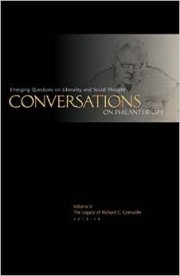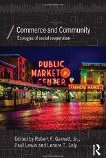Invisible Gnomes and Visible Samaritans
Mises Daily has posted a wonderful explication by Paul Cantor of the libertarian themes in the politically incorrect television show South Park. Cantor’s account of the second season episode “Gnomes” points us to the strange and mysterious workings of the invisible hand.
We know two things about these strange beings: (1) they are gnomes; (2) they are normally invisible. Both facts point in the direction of capitalism. As in the phrase “gnomes of Zurich,” which refers to bankers, gnomes are often associated with the world of finance. In the first opera of Wagner’s Ring Cycle, Das Rheingold, the gnome Alberich serves as a symbol of the capitalist exploiter—and he forges the Tarnhelm, a cap of invisibility. The idea of invisibility calls to mind Adam Smith’s famous notion of the “invisible hand” that guides the free market.
In short, the underpants gnomes are an image of capitalism and the way it is normally—and mistakenly—pictured by its opponents. The gnomes represent the ordinary business activity that is always going on in plain sight of everyone, but which people fail to notice and fail to understand. South Park’s citizens are unaware that the ceaseless activity of large corporations like Harbucks is necessary to provide them with all the goods they enjoy in their daily lives. They take it for granted that the shelves of their supermarkets will always be amply stocked with a wide variety of goods and never appreciate all the capitalist entrepreneurs who make that abundance possible.
What is worse, the ordinary citizens misinterpret capitalist activity as theft. They focus only on what people in business take from them—their money—and forget about what they get in return, all the goods and services. Above all, people have no understanding of the basic facts of economics and have no idea of why those in business deserve the profits they earn. Business is a complete mystery to them. It seems to be a matter of gnomes sneaking around in the shadows and mischievously heaping up piles of goods for no apparent purpose.
Cantor elucidates the spillover benefits from the busy-ness of the gnomes by pointing us to Adam Smith’s classic discussion of the “invisible hand” in The Wealth of Nations:
By preferring the support of domestick to that of foreign industry, he intends only his own security, and by directing that industry in such a manner as its produce may be of the greatest value, he intends only his own gain, and he is in this, as in many other cases, led by an invisible hand to promote an end which was no part of his intention. Nor is it always the worse for the society that it was no part of it. By pursuing his own interest he frequently promotes that of the society more effectively than when he really intends to promote it. I have never known much good done by those who affected to trade for the publick good.
The whole discussion seems to shed reflected light on the relationship between capitalism and philanthropy. Far from being a corrective to capitalist exploitation, philanthropy may be seen as a complementary means of satisfying needs and treating other people with dignity. By deliberately and instrumentally pursuing their own interests (which of course can encompass the interests of our “little platoons” or “tribes” of intimate others), the invisible gnomes of the market benefit both known and unknown others. Philanthropy, by contrast, is most often the work of visible Samaritans who deliberately and instrumentally seek the good of known others, or some abstract good they equate with the “public interest.”
Modern liberalism has often fostered an antipathy between the “self-interest” of capitalism, including the favoritism we have for our families and friends and “little platoons”, and the “altruism” of philanthropy. Marxism taught that the personal must be subsumed to the collective, and in Gramsci’s formulation, the personal was inseparable from the political. Modern liberalism has continued to valorize self-abnegation and altruism, which in the Kantian formulation is action that can have NO TRACE of self-interest.
But this is a problematic account of human behavior as it really is and an unrealizable motivational ideal for human action. We cannot be good Samaritans 100% of the time, for the good Samaritan can help only if he or she already possesses some resources that can be used to help. And even when we take up the role of the good Samaritan in specific contexts, the act of philanthropy is fraught with challenges. The good Samaritan may be tempted to impose his own vision of the good of the other, rather than the good the other might choose for himself. The Samaritan’s gift, as gifts can do, may leave the one helped in a position of obligation and debt to the helper. The Samaritan, as does Mrs. Jellyby in Dickens’ Bleak House, may also compromise the well being of her family through inordinate sacrifice of time, attention, and/or material resources.
The presence of these dilemmas does not diminish the virtue of philanthropy, but suggests that we have to be careful when we step out of the sphere of minding our own business. We have suggested that philanthropy might best be thought of as the love of what it means to be human, which suggests that the restoration of dignity should be at the heart of the business of philanthropy. But we work today with a very confused notion of dignity, too often believing that it is primarily defined by the absence of inequality, which we then tend to measure primarily by looking at material wealth. Equality is thus the quest, and income inequality is thus the scandal, of the modern age.
In his new book Against Fairness, Stephen Asma offers us a corrective to the modern liberal pursuit of fairness in the sense of equal shares, equal outcomes, the absence of bias, Rawlsian justice as fairness, and the prioritization of the ethic of altruism over the ethic of favoritism. Asma describes and critiques the “grid of impartiality” that has come to dominate liberal secular morality in Western cultures.
Asma’s initial offering of a corrective is welcome. But it is only a starting place from which we can begin to work harder to understand the complexion of human dignity. We rush to eliminate suffering, and rightly so, sometimes failing to see the great dignity that can shine through the moment of suffering. With the advent of the modern nonprofit corporation, we often outsource our charity, buffering ourselves from the indignities of rolling up our sleeves to care for the poor, the diseased, and the broken. We believe that if we can bring people up to relatively equal levels of material wealth, we can achieve some level of dignity that discharges our social responsibility. But this may all be missing the point that dignity has a two-fold character, it arises in part from our equal status as human persons, as ends in ourselves, but is also manifest as we grow into the fullness of human potentiality, capable of freely cultivating our talents to create and contribute; capable of participating in the human world of giving, receiving, bartering and trading according to principles of reciprocity; capable of constraining short-term cheating out of self-preference when cooperation and fairness will benefit us better in the long run; capable of acts of heroic sacrifice and radical generosity; capable of asking for and receiving with gratitude help when we truly need it; capable of refraining from asking for help before we have brought our own powers to bear on a problem; capable of applying our powers of moral imagination to reflect upon our biological sympathies with others in ways that lead to greater identification with them; capable of thus communicating and communing.
This reflection needs more work, but we might begin to see that we ourselves, simply in aspiring to live into the fullness of the virtues of our humanity, are at once the invisible gnomes of the market and the visible Samaritans of the community, and this whole business of living in dignity, worth our humanity, depends upon us not pitting our right hand against our left. What we create and earn on the one hand is the very stuff we have to trade and give on the other.
In the end, the business of life is a journey in which the abstract, altruistic, egalitarian ethical systems offered by modern liberal philosophy can never displace the need for the cultivation of contesting human virtues and the exercise of prudence.
As Asma points out: “People are not equally entitled to my time, affection, resources, or moral duties–and only a naive imagination can make them appear so. (142)”
But Cantor also reminds us that the market offers us another space for satisfying human needs and desires: “The economy does not need to be guided by the very visible and heavy hand of government regulation for the public interest to be served. Without any central planning, the free market produces a prosperous economic order. The free interaction of producers and consumers and the constant interplay of supply and demand work so that people generally have access to the goods they want.”
Philanthropy, in the pursuit of social change and social justice, has increasingly become the work of enlisting government action to regulate the domain of the gnomes because it knows not what they do. Justice is no longer the business of punishing a naughty gnome, but trying to ensure that no gnome can ever be naughty. Philanthropy might be truer to its love of what it means to be human if it worked harder to help us all develop our gnomish potential, expanding that potential to encompass our ability to participating in the great, dignifying conversation of mankind, where gnomes and Samaritans are really one in the same and all can be welcome.




